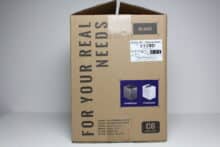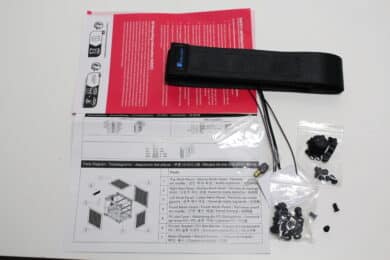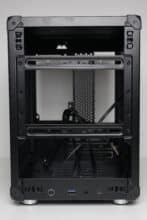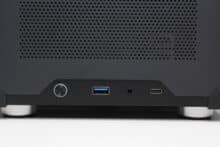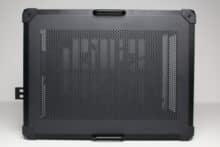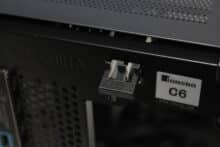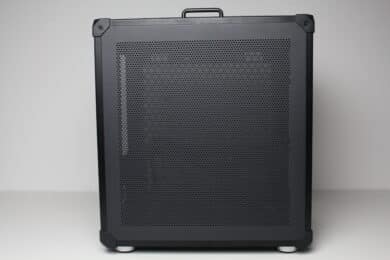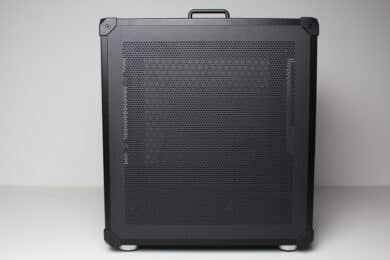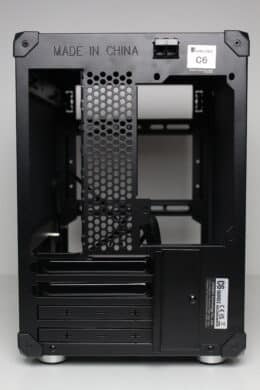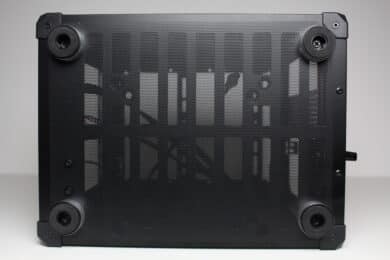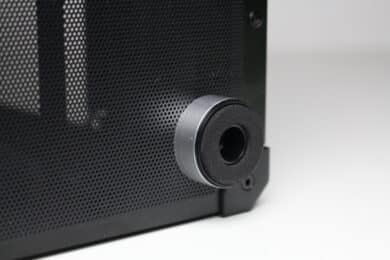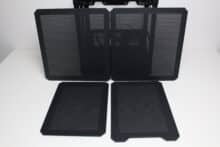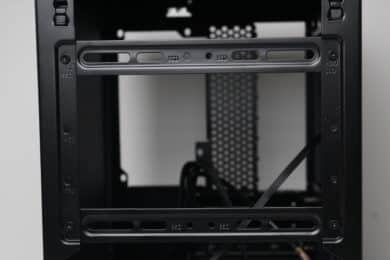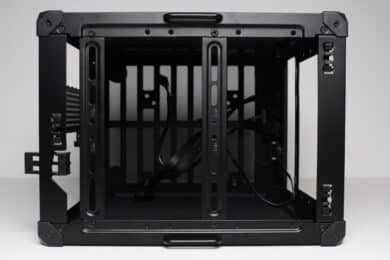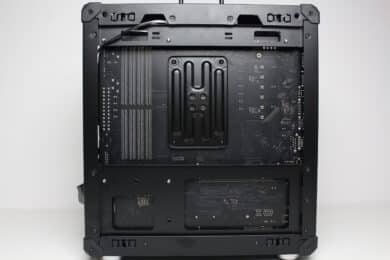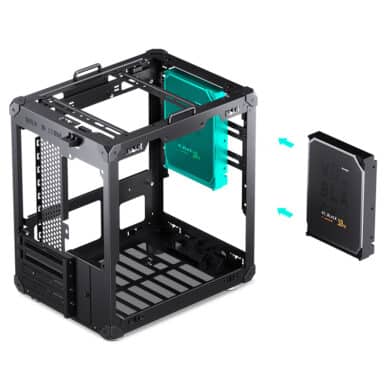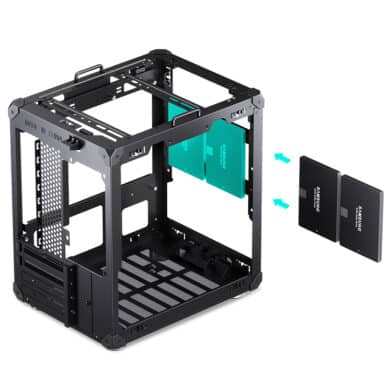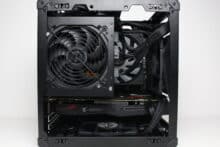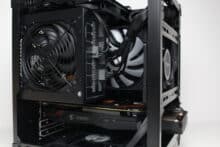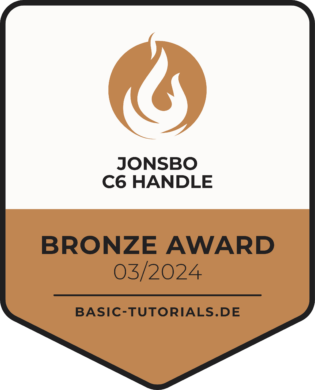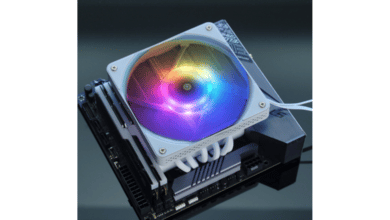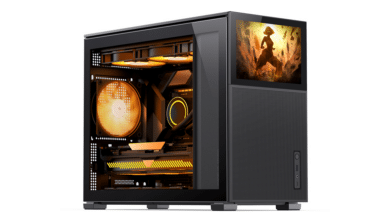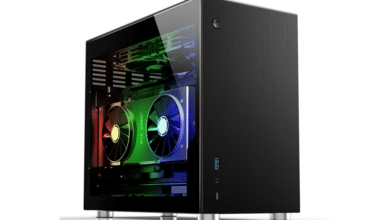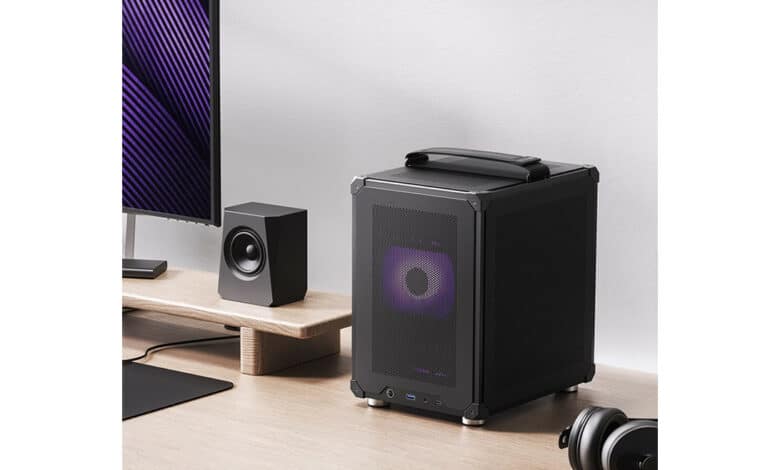
Jonsbo is a globally renowned Chinese manufacturer of computer components. In addition to ATX, µATX and ITX cases, the product portfolio now also includes CPU coolers and AiO water cooling systems. Jonsbo focuses primarily on a particularly extravagant design, which at the same time does not forget the intended use of the case. In January 2024, the manufacturer presented a new and interesting case which, at just under 16 liters, is smaller than many ITX cases, but still supports a µATX mainboard and a full ATX power supply unit. The mini tower goes by the name of Jonsbo C6 Handle and we take a closer look at it in this test.
Technical details
| Model: | Jonsbo C6 Handle |
| Case type: | µATX |
| Dimensions: | 202 mm (W) x 266 mm (H) x 295.2 mm (D) |
| Weight: | 2.3 kg |
| Material: | Steel, plastic |
| Color: | Black |
| Front connections: | 1x USB-C 3.2 Gen2 (5Gbps), 1x USB-A 3.0 (5Gbps), 1x HD audio |
| Drive bays: | 1x 3.5″/ 2x 2.5″ (blocks one fan slot) |
| Expansion slots: | 4x horizontal |
| Form factors: | mATX, ITX |
| Ventilation: | Front: 1x 120 mm Top: 1x 120 / 1x 140 mm Bottom: 1x 120 mm / 1x 140 mm |
| Radiators: | N/A |
| Max. CPU cooler height: | 75 mm |
| Max. Graphics card length: | 255 mm (if the PCIe slot is at the top) 200 mm (if GPU is thicker than 48 mm or GPU in a deeper PCIe slot) |
| Max. Power supply length: | 185 mm |
| Price: | € 49.90 * |
| Special features: | Dust filter, carrying handle, tool-free panel mounting |


Jonsbo C6 Handle Test: The scope of delivery
The manufacturer packs the Jonsbo C6 Handle in a very compact cardboard box. In addition, no elaborate colors or imprints are used. Instead, the box remains a plain brown and a few schematic drawings and a list of the technical data can be seen.
Inside the box, Jonsbo wraps the C6 in a plastic film and two blocks of elastic foam. Although these are somewhat thinner compared to previously seen blocks, they should be sufficient protection due to the low weight of this mini tower. Jonsbo places the accessories in the interior. There are a few sachets with the necessary mounting screws, a nut for screwing in the spacers, a handful of cable ties, the non-pre-installed carrying handle and assembly instructions and a card with warranty information.
Exterior impression
The Jonsbo C6 is very compact for a mini tower. With its dimensions of 202×295.2x266mm and a volume of around 16 liters, it is barely larger than two shoe boxes and already competes with some ITX cases. In addition to the dimensions, the weight of the C6 also speaks for good portability. The cube case only weighs 2.3 kilograms in total.
Visually, the Jonsbo C6 looks rather restrained, but the surrounding mesh panels at least add some zest. The front panel is made of steel and is attached to the body using push pins. It also has a large mesh grille consisting of many small holes. The I/O panel, consisting of two USB ports (1xUSB-C, 1x USB-A), an HD audio combo port and the white illuminated power button, is also located on the front.
A modular steel panel with a mesh structure is also used on the lid. Both the design of the ventilation openings and the push-pin attachment remain identical. However, there is a plastic lever at the rear that can be used to release the steel panel. There are also two eyelets and a carrying handle with Velcro strips that can be pulled through the eyelets.
Jonsbo has also designed the side panels identically. Both are made of black-grey steel, have a push-pin mounting and are perforated over a large area. The perforation corresponds visually to the front panel or cover element. Here too, Jonsbo has most likely dispensed with dust filters, as the fine structure of the openings is intended to act as a filter itself.
A look at the back of the C6 quickly shows how the system will be structured inside. The openings for the vertically mounted power supply unit can be seen on the right-hand side. To the left, we can see a ventilation opening and the cut-out for the motherboard cover. In the lower area, we find four slots for expansion cards, two of which are equipped with reusable slot covers.
Unlike the rest of the sides, the base consists of a few steel struts and a much coarser ventilation grille, in front of which Jonsbo places a mesh dust filter mat. If you want to fit the existing 120 mm or 140 mm fan slot with a fan, you first have to remove the four case feet, as these hold the dust filter in place. Unfortunately, this is a little awkward. Speaking of the feet, they are made of plastic, have a silver border and a layer of foam rubber to reduce vibrations.
Interior impression
The interior of the Jonsbo C6 has a very simple design. There is a main chamber in which all relevant components can be placed. This includes the µATX or ITX mainboard, the CPU cooler, the graphics card, the power supply unit and up to three fans. There are no cable management openings, as the mainboard spans the entire tray and no cables can be routed behind it anyway. On a positive note, the body is very stable even without side panels.
This stability is achieved, among other things, by the four cross braces in the front and in the lid, which can be used to mount data carriers or case fans. The struts can be screwed on at different points and have a rail system to be able to react flexibly to the component alignment inside.
Although the right side panel can be removed from this case, there is not much to see behind it. There is neither space for cables nor can any other components be placed there. However, you can easily reach almost every part of the rear of the mainboard. This can be particularly important if it has SSD slots at the rear or if you want to retrofit a CPU cooler with a backplate.
If you install a system in the Jonsbo C6, you don’t have to do without data carriers altogether. The mounting frame in the front allows, as an alternative to the 120 mm fan, the installation of a 3.5″ HDD or two 2.5″ SSDs. However, as an installed system is most likely dependent on every bit of cooling, the installation of a fan would probably be the more sensible choice.
Processing
In terms of workmanship, we have nothing to complain about with the Jonsbo C6 Handle. Almost all components are made of solid steel, have a clean finish and make a stable impression. We couldn’t find any sharp edges and even without side panels, the body remains sufficiently stable. We also found the feel of the side panel assembly to be positive. Although the lever for releasing the top panel is only made of plastic, it also makes a durable impression.
Jonsbo C6 Handle test: Installing the components
Now we come to the system installation for the Jonsbo C6 Handle Test. As hardware we use an AMD Ryzen 7 5700X* on an ASRock B550M PG Riptide* with 64GB Corsair Vengeance DDR4 3200MHz*. The Ryzen is cooled by a Thermalright AXP120-X67 Black ARGB*. A Gigabyte AORUS GTX 1060 6GB is responsible for the image output. Power is supplied by the fully modular Endorfy Supremo FM5 Gold with 650W*.
The installation of the test system proved to be a bit of a challenge in some cases, but compared to some ITX systems it was still quite straightforward overall. It is important to follow a certain sequence. Starting with the mainboard, the next step is to connect the case connections and the cables of any fans. However, the fans are not yet installed at this stage. This is followed by the connection of the power supply cables and the installation of the power supply unit, in this order. As a final step, we would recommend installing the fans and the graphics card.
The real challenge, however, is the cabling. There is not much space between the components, nor does the Jonsbo C6 offer eyelets for the use of cable ties. The majority of the cables are therefore forced to remain directly behind the front fan and can only be tamed somewhat using cable ties. Due to the flexible cables of our power supply unit, we were able to clamp some of them behind the case fans, so the overall result is quite presentable.
The layout used and the compact dimensions of the Mini-Tower limit its hardware compatibility somewhat. The built-in CPU cooler can be a maximum of 75 millimeters high and the graphics card a maximum of 255 millimeters long. If the pixel accelerator is also thicker than 48 millimetres or is installed in the second PCIe slot, the GPU may only be 200 millimetres long. A maximum of 185 millimeters of space is available for the ATX power supply unit.
The Jonsbo C6 only has space for a radiator in the front if an ITX mainboard is installed instead of the µATX mainboard. However, even then there is a very high risk that the radiator will collide with the PCB of the graphics card. Officially, it is not possible to install a radiator in the Jonsbo C6 handle.
Load test
Finally, we come to the temperatures reached in the Jonsbo C6 Handle test. During the stress test, Prime95 and FurMark were run at a room temperature of 20 °C for 30 minutes. The stress test was also carried out in the factory state (without fans) and with three fans (Alpenföhn JetStream 120 mm).
Scenario |
Temperature |
| CPU: 50% PWM (900 rpm) GPU: 50% PWM (1650 rpm) without fan (factory setting) |
CPU: 80 °C (CPU clocks down to 2.7 GHz) GPU: 81 °C |
| CPU: 50% PWM (900 rpm) GPU: 50% PWM (1650 rpm) Front: 1x Alpenföhn JetStream 120 50% PWM (890 rpm) Top: 1x Alpenföhn JetStream 120 50% PWM (890 rpm) Bottom: 1x Alpenföhn JetStream 120 50% PWM (890 rpm) |
CPU: 70.5 °C GPU: 80.4 °C |
| CPU: 50% PWM (900 rpm) GPU: 50% PWM (1650 rpm) Front: 1x Alpenföhn JetStream 120 100% PWM (1600 rpm) Top: 1x Alpenföhn JetStream 120 100% PWM (1600 rpm) Bottom: 1x Alpenföhn JetStream 120 100% PWM (1600 rpm) |
CPU: 66.0 °C GPU: 73.1 °C |
| CPU: 50% PWM (900 rpm) GPU: 50% PWM (1650 rpm) Front: 1x Alpenföhn JetStream 120 100% PWM (1600 rpm) Top: 1x Alpenföhn JetStream 120 100% PWM (1600 rpm) Bottom: 1x Alpenföhn JetStream 120 100% PWM (1600 rpm) |
CPU: 56.9 °C GPU: 64.7 °C |
During the stress test, it unfortunately became apparent that cooling the components in the Jonsbo C6 Handle can be quite a challenge. Without additional case fans, the CPU quickly reaches its temperature limit and clocks down. If you mount three fans and let them rotate slowly, things look a little better overall, but still far from good. At full fan speed, the temperatures are finally good, but the generated noise is no longer. Sadly, the biggest difference is achieved by removing the perforated side panels, which appear to have been designed far too restrictively.
Jonsbo C6 Handle test: Conclusion
Now we come to the conclusion of the Jonsbo C6 Handle test. The mini tower impressed us above all in the areas of workmanship and compactness. Overall, the µATX case makes a high-quality impression thanks to the very high steel content and is sturdily assembled. With a total volume of just 16 liters, it is also very compact and still offers space for a µATX mainboard and an ATX power supply unit. Another nice feature is the carrying handle, which makes transporting the already lightweight tower even easier.
Unfortunately, we also found negative aspects with the C6. The compact dimensions and the chosen layout automatically mean that the restrictions for possible CPU coolers and graphics cards are quite large. This is unfortunately compounded by the moderate airflow caused by the restrictive side panels. This means that the C6 Handle is not particularly suitable for high-performance gaming systems, neither from a compatibility nor a cooling perspective.
The purchase price of € 49.90 * seems altogether reasonable for this mini tower. If you are looking for a particularly compact case that still has space for a µATX mainboard and an ATX power supply, then the Jonsbo C6 Handle would be a possible candidate. In this case, however, you will have to lower your expectations in terms of compatibility and cooling.
Jonsbo C6 Handle
Workmanship
Structure
Features
Cooling
Value for money
79/100
The Jonsbo C6 Handle is a high-quality and particularly compact mini tower that also has a practical carrying handle. However, the moderate airflow due to the restrictive side panels is the biggest drawback of this mini tower.





